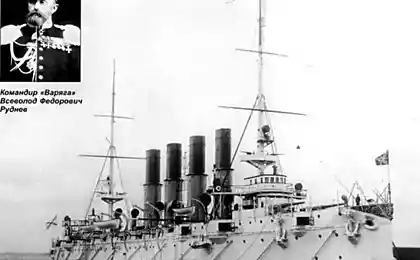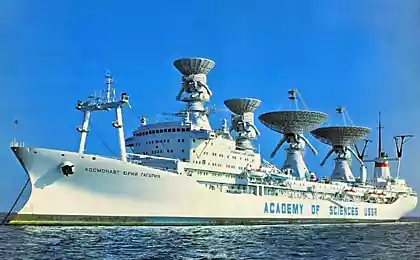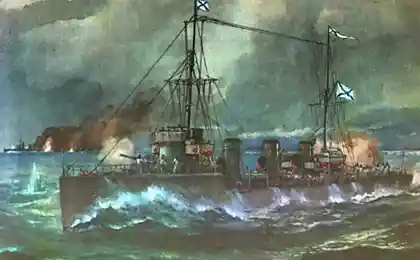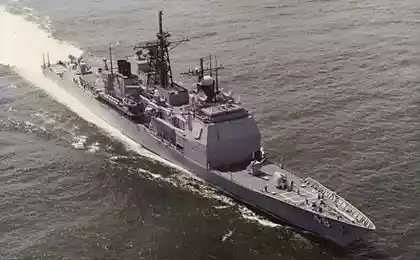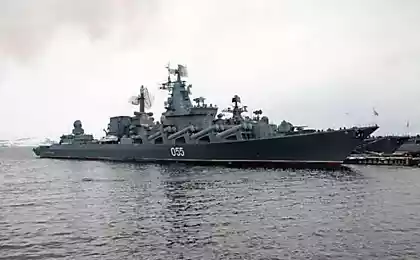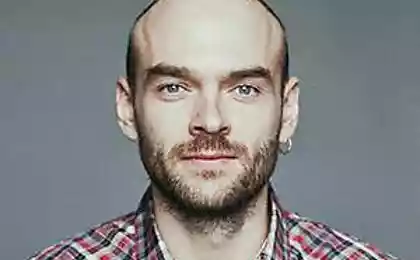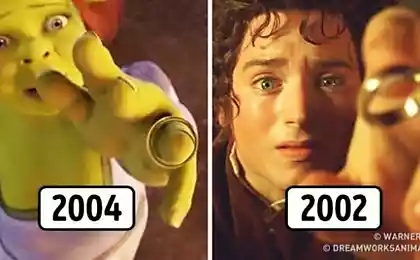1995
Top warships of the twentieth century (10 pics + text)
Known Channel Military Channel continues to "rejoice" rating. We have previously considered the best rifles, tanks, helicopters and heavy bombers. Today, let's talk about waterfowl technique.
Among the ten best ships of the world there was not one of ours. As well as a Japanese, Italian, French. Six out of ten positions are occupied by the Americans. Two places to pick up a British and two Germans generously contributed.
10. The cruiser "Hood" (Great Britain)
HMS Hood (EVK "Hood") - British battle cruiser fleet. Named in honor of Samuel Hood, British admiral of the XIX century. During the construction of "Hood" was planned to take into account the experience of the Battle of Jutland, which resulted in the UK KVMF lost three battle cruisers. However, despite all the improvements the ship died May 24, 1941 in a battle with the German battleship "Bismarck". Tselnoklepany body assembled on the longitudinal framing system. The ship has two internal vertical fin at the DP and the dock keels. The body is divided by watertight bulkheads up to 25 compartments. All transverse bulkheads reach the upper deck. Double bottom extends for 218 meters. There were bilge keels. Stem yachting form. Boiler and turbine department occupied 90 m amidships. The ratio L / B = 8.42. Increased rainfall of 1 cm - 50 tons. Metacentric height in normal displacement - 0, 99m, with full - 1, 28 m. 69 ° angle sunset and 73 ° respectively. 8 orudy caliber 381 mm (15 & quot; / 42 Mark I) in the twin tower installations such as Mk.II All ammunition 640 rounds (80 on the trunk). In wartime, the barrel 132. Maximum vertical elevation angle of 30 °, with the range of a projectile 27 200 m. (147 CC) field of fire - 300 ° for each tower. Charging at any position of the barrel (to angles less than 20 °). Turn carried out using hydraulic actuators. The angular velocity of rotation of the tower - 2 ° / sec. Vertikalnaya speed pickup barrel - 5 ° / sec. Diameter Barbette - 9 meters. Tower GC were in the form of a polyhedron, their book was carried out Krupp cemented armor thick forehead - 381 mm, the front side - 305 mm; on the sides and stern - 279 mm, the roof - 127 mm. The total mass of the rotating part of the tower of the Civil - 860 tons. Mine caliber 140-mm rapid-fire gun sample BL.Mk.I installations CPII, in the sample carriage Mk.II, the elevation angle of 30 °, the firing range 16 200 m (87 CBT) booking: front 38 mm; on each side of 25 mm; rear open. 150 rounds on the barrel.
Anti-aircraft guns: 4102 mm gun barrel length of 45 calibers QF.Mk.V sample in sample installations Mk.III.HA, the elevation angle of 80 °. Machine gun mounted on a sample Mk.IV. Guns and guidance manual charging rate of 9-12 rounds per minute, range in height 8700 meters. Ammunition 200 rounds on the barrel. 2 47-mm cannon salute Hotchkiss boekomlektom with 64 shots on the trunk. (dismantled in 1939)
Reservations: 305-mm oblique (12 °) armor belt, height of 2 to 9 m, set on laying teak for 171, 4 meters (Behind him trim body had a thickness of 51 mm) from him to the upper deck (width 2 75 m) 178 mm belt.
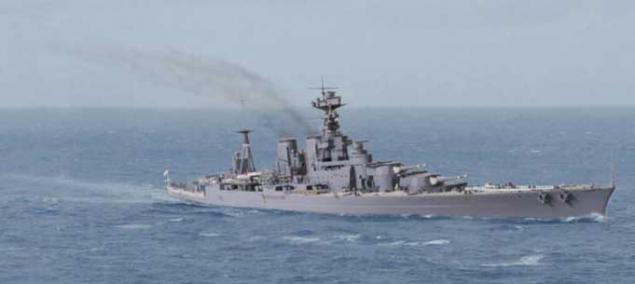
9. "pocket battleship" (Germany)
Heavy cruiser of the "Deutschland" - type heavy cruiser Kriegsmarine WWII. There were built 3 units: "Deutschland» (Deutschland), «Admiral Scheer» (Admiral Scheer) and "Admiral Graf Spee» (Admiral Graf Spee).
In the pre-war German Navy battleships were registered (Panzerschiffe). On January 25, 1940 reclassified in the heavy cruiser. The naval literature is widespread, the term "pocket battleship» (Pocket battleship) - an ironic classification of ships, was invented by the British press of the 1930s. The housing design "pocket battleships" differed significantly from the German light cruisers, famous for its fragility. "Deutschland" had long ocean raids and to ensure reliability approached very seriously. Although widely used in the construction of welding, all the responsibility of the United duplicated klёpkoy share of aluminum in construction accounted for only 1%. As a result, the cruiser had no problems with the strength, to ensure that work and internal armored bulkhead.
On the "Deutschland" established for traditional German navy foremast in the form of a hollow tube, which placed the wheelhouse and rangefinder post. Experience has shown that such a structure to vibrate, and its subsequent cruisers were replaced by easily recognizable, bashennopodobnuyu superstructure. Trump card of new ships is their main gauge - 283 mm guns SK C / 28. Designed from scratch, they had no equal among weapons of comparable tonnage ships. Barrel length was 52, 35 caliber projectile initial velocity of 910 m / s, but it was quite acceptable survivability. Use three types of ammunition, all weighing 300 kg:
The armor-piercing, containing 7, 84 kg of explosives (2, 6% of the weight of the projectile);
Polubroneboyny [11] - 16, 94 kg (5, 65%);
Explosive - 23, 3 kg (7, 8%).
This combination provided good ammunition to fire at a variety of targets. The firing range at the maximum elevation angle of 40 ° reached 36,475 meters. Ammunition ranged from 105 to 120 shells per gun. Charging system for a fixed angle of 2 ° allows up to three volleys in a minute on the barrel, the practical rate of no more than two. These characteristics provide assurance defeat of lightly-ships and even the heavy protected cruisers were vulnerable to any distance.
The photo - a heavy cruiser "Deutschland»

8. The aircraft carrier "Essex" (USA)
Type "Essex" (eng. Essex class) - a series of heavy shock US aircraft carriers during World War II. Designed in 1938-1940, while originally intended to build only one ship of this type, in addition to the aircraft carriers of the "Yorktown". However, soon it was ordered two more, and the entry of the US into the war in December 1941 required the mass construction of aircraft carriers, as that is the most modern type has been selected, "Essex". In total, from 1940 to 1945 it was built 24 type aircraft carrier "Essex", making them the most numerous series of aircraft carrier in history, not counting the escorts, as well as the most numerous series of naval vessels with a displacement of more than 20 000 tonnes.
The first of the carriers of the "Essex" was commissioned in December 1942, and in 1943 they became the main type of heavy US aircraft carriers and actively used until the end of the war, with at the same time none of them was lost, although a few of the carriers received serious damage. In the early postwar years, 14 of them were put in the reserve, with part of it is not output. In the years 1949-1953, most of them underwent a major upgrade, with the upgraded ships became known as the "type" Oriskany ", named after the first of them, rebuilt for another berth. As such, they have been used in a number of post-war conflicts, including the Korean and Vietnam wars, but in the late 1960s - early 1970s, most of these obsolete ships were decommissioned. Only one of them, "Lexington", remained in service as a training aircraft carrier until 1992.
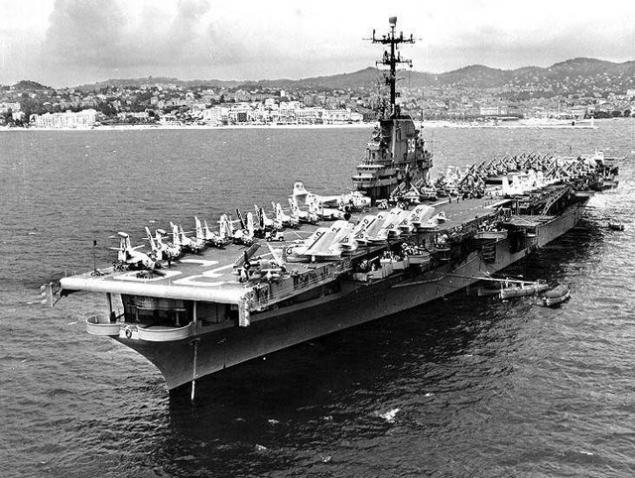
7. The battleship "Bismarck" (Germany)
"Bismarck" - a battleship of the German Navy, one of the most famous ships of World War II. Named after the first chancellor of the German Empire, Otto von Bismarck. During his only campaign in May 1941 sank in the Denmark Strait British flagship battlecruiser "Hood" (eng. HMS Hood). The outbreak then hunt for the British Navy "Bismarck" Three days later, it was over the sinking. Class "Bismarck" (later built another ship of this class - the battleship "Tirpitz") was originally created as a successor to "pocket battleships" and is mainly intended for the conduct of the raid operations against merchant ships. Thus, the amount of fuel reserve "Bismarck" more characteristic of the battleships of the Pacific, and shown in trials in the Baltic Sea at the rate of 30, 1 units was one of the best values for these ships. "Bismarck" was the first after World War I battleship full German fleet: armament includes eight 380-mm guns SKC-34 in four towers, allowing him an equal withstand any battleship. "Bismarck" during his service was the largest battleship in the world, and the class of "Bismarck" is the third largest (after the Japanese "Yamato" and the American "Iowa") class battleships in history.
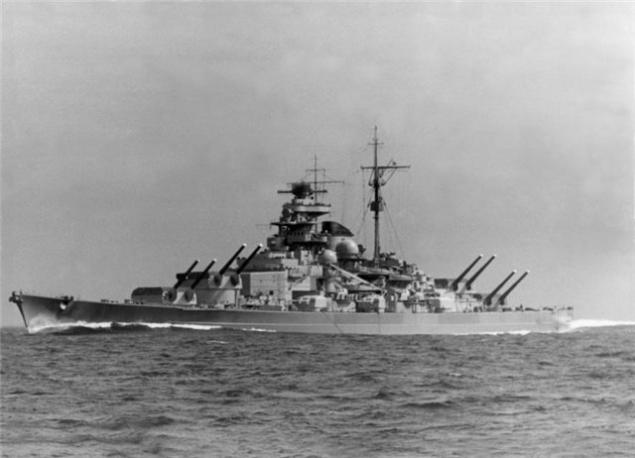
6. Battleship "North Carolina" (USA)
The first sketches included the construction of ships, armed with nine 365 mm guns capable of speeds of 30 knots. But as the development of the project was enhanced armament to 12 guns of 365 mm, resulting in lower design speeds up to 28 knots. And after US intelligence reported that the Japanese refused to limit guns in caliber 356 mm, it was decided to increase the caliber of the guns to 406 mm.
The construction of the battleship "North Carolina" was launched on the US Navy shipyard in New York, October 27, 1937. On the water the ship was launched June 13, 1938, and entered into service April 9, 1941. However, a number of technical problems could not eliminate quite a long time, resulting in readiness for combat operations was achieved only at the beginning in 1942.
After that the battleship was sent to the Pacific Ocean in the middle of July 1942. There 'North Carolina' is included in the Task Force 26 (which also includes the aircraft carrier Enterprise, Wasp and Saratoga) and is used as a cover for aircraft carriers during the operation in the Solomons. Baptism of fire the battleship was August 24, 1942, protecting the carrier battle groups from the Japanese air attacks. September 15 "North Carolina" gets hit by a torpedo fired submarine «I-15." During the explosion killed two sailors, but the damage to the ship were very serious - down came the bow tower of the main fire and the ship had to be sent for repair at Pearl Harbor. "North Carolina" was removed from the Navy June 27, 1947 and transferred to the reserve.
In August 1961, the ship was purchased by the administration of the State of North Carolina on donations of residents of the state and towed to Wilmington.
On April 29, 1962 the ship operates as a museum.
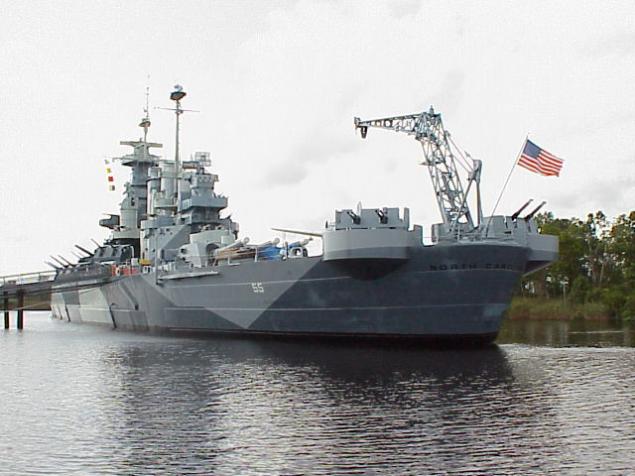
5. Destroyer "Fletcher" (USA)
Destroyers of the "Fletcher" - type destroyers during World War II, which consists in the US Navy. After the Second World War and the beginning of the Cold War destroyers of the "Fletcher" is gradually transferred to the Navy military and political allies. The destroyers of the "Fletcher" are the best known US destroyers and most large-batch type destroyers in the world in the history of the Navy. The four destroyers of the "Fletcher" in natsoyaschee time are the Museum Ship. Ships took an active part in hostilities at sea during the Second World War. During the 1943-1945 biennium. US Navy lost 23 destroyers of the "Fletcher" of 175 units delivered to the US Navy. In the postwar period, with increasing capabilities of Soviet submarines and increase their activity in the oceans, the United States began to implement a program to increase emergency fleet antisubmarine capabilities, including anti-submarine capabilities destroyers like "Fletcher". After the failure of modernization "Fletcher" program FRAM, destroyers of this type began to lease or sell a friendly foreign governments. The first destroyers like "Fletcher» Change naval flag, steel destroyers Capps and David W.Taylor, sent Spain May 15, 1957. This Capps was renamed in honor of one of the greatest naval battles in history - the Battle of Lepanto. Germany in January 1958 received a USS Anthony (DD-515), which entered into service Bundesmarine as Z-1 (Zerstoerer-1). Then he was joined by five other ships, the latter became part of the German Navy in April 1960. Japan received this type of 2 destroyers - USS Heywood L. Edwards and Richard P. Leary. Both were transferred to the Maritime Self-Defense Forces of Japan in March 1959 Argentina, Brazil, Greece, Italy, Mexico, the Republic of Taiwan, Turkey, Chile, Peru, Colombia and the Republic of Korea has also been transferred to the destroyers of this type. All of the above 14 countries was transferred from the US Navy destroyer type 53 "Fletcher".
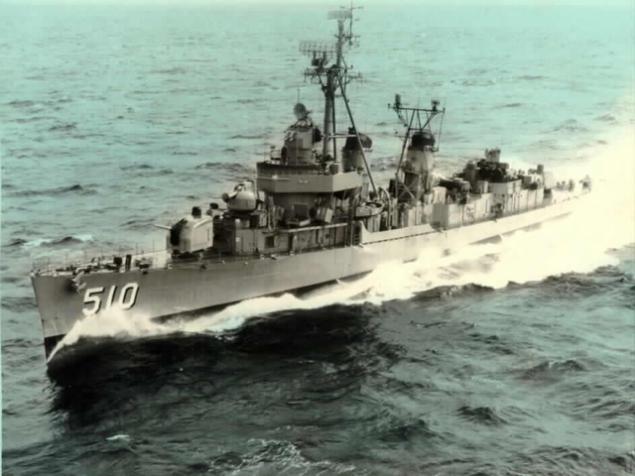
4. The cruiser "Ticonderoga" (USA)
Type missile cruisers, standing in the service of the Navy of the United States. Development of the project started in 1978. Battlestar like "Ticonderoga" have a characteristic elongated body with far aft forecastle extending by 85%. its length, klipersky nose and transom stern. Hull lines designed to meet the decrease in the amplitude roll and pitch, and water resistance to movement of the ship. On the basis of operating experience destroyers type Spryuens total length of the ship by lengthening the bow was increased by 1, 1 meter on it established a special bulwark length of about 40 and a height of about 1 to 4 m in order to reduce the impact of the waves in stormy weather on the nasal installation - 127 -mm. AU and OHR (installation of vertical launch). With the same purpose cruiser equipped with stabilization system pitching and side keels.
According to the project for a long time cruiser must maintain a speed of 20 kt at the 7-point agitation. Chimneys are spaced apart along the sides and the length of the ship. For the navigating bridge and in the middle part of the superstructure lattice masts are located. In the first five ships of the "Ticonderoga" stationed conventional girder universal setting for launching anti-ship missiles "Harpoon" anti-aircraft "Standard" and anti ASROK. But in 1986 the US Navy did install vertical launch (OHR) missiles with a mesh containers. Application OHR possible to increase the survivability of the installation, increase the range of ammunition and launched rockets to reduce the reaction time. Typical loading OHR on the sixth and subsequent cruisers "Ticonderoga" - 26 cruise missiles "Tomahawk", 16 and 80 Plourac'h ASROC missiles "Standard-2" - only 122 missiles in two modules.
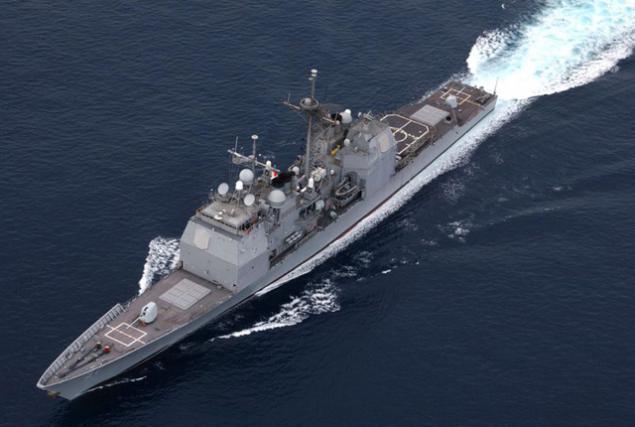
3. Battleship "Queen Elizabeth" (Great Britain)
Displacement: 36 450 tons
Engine: a four steam turbine capacity of 80 thousand. L / s
Speed: 23 knots
Cruising: 4 500 nautical miles at 12 knots
Protection: the maximum thickness of armor - 32, 5 cm
The main armament: eight guns
pyatnadtsatidyuymovyh The crew of 1190 people.
Time of use: 1913-1945 gg
Dreadnoughts type Queen Elizabeth - superdreadnoughts five British Royal Navy. The first vessel of the series was named in honor of Queen Elizabeth I. This series of ships surpassed their predecessors - dreadnoughts such as Iron Duke in the Royal Navy firepower, armor protection and speed. German dreadnoughts type Konig also inferior to those ships, such as dreadnoughts but Bayern were comparable in characteristics, except for a lower speed.
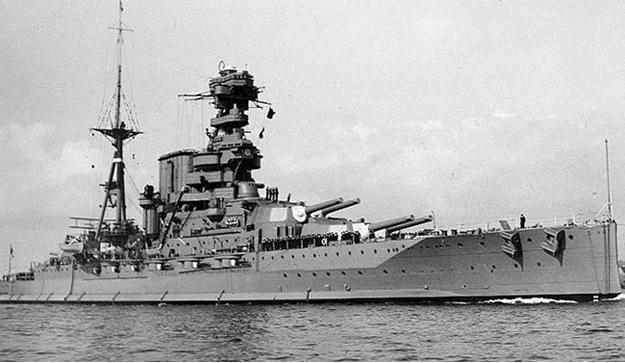
2. The aircraft carrier "Nimitz" (USA)
"Nimitz" (eng. USS Nimitz (CVN-68)) - US aircraft carrier, the first of a series of Nimitz-class ships. The name was in honor of Chester Nimitz - Chief of the US Pacific Fleet during World War II.
It laid on 22 June 1968, launched on May 13, 1972 May 3, 1975, with the participation of President Gerald Ford introduced in the fleet.
The first campaign committed to the Mediterranean Sea, becoming the first ten years of the American ship with a nuclear power plant, who came into the Mediterranean Sea.
In February 2008, in the Pacific, two Tu-95MS strategic aviation Russia simulated an attack on the aircraft carrier Nimitz, flying in the immediate vicinity. When the Russian aircraft to the ship was about 800 km to the interception were raised four F / A-18. At a distance of 80 km from the aircraft carrier group of American planes were able to intercept Tu-95MS bombers, but despite this, one of the two strategic bombers passed over the "Nimitz" at an altitude of about 600 meters, the second went 90 km away from the ship.
Tonnage: 97000 tons
Length: 332, 8 m. 317 m at the waterline
Width: 76 8 m. Waterline 40, 8m
Draught: 11 m 3
Technical data
Powerplant: 2 reactor 4 of the turbine.
Power: 260000
Speed: 30 knots (56 km / h)
Crew: 3200 people + Wing 2480 people
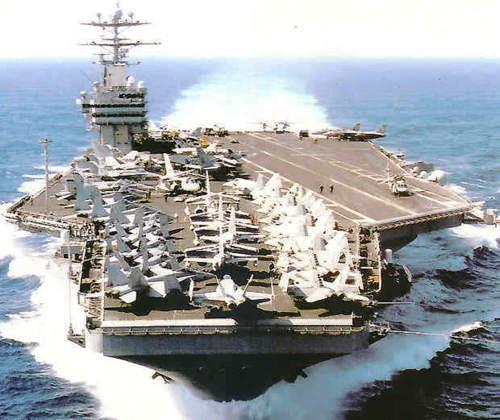
1. Battleship 'Iowa' (USA)
Battleship 'Iowa', one of the strongest cards in the deck of the US Navy during the battle with Japan during World War II, is a fine example of the powerful floating fortresses, sea explorers era dreadnoughts.
The opinion of experts that the ship is one of the best battleships of the world is difficult to disagree because even battleships built in the late 30s leading maritime powers, and had some superiority over the "Iowa" in some parameters, but no one of them has been so carefully and well balanced combination of all the basic combat characteristics. It is no accident, "Iowa" is sometimes compared with the German battlecruisers World War I, which is considered a classic heavy artillery ship.
Source:
Among the ten best ships of the world there was not one of ours. As well as a Japanese, Italian, French. Six out of ten positions are occupied by the Americans. Two places to pick up a British and two Germans generously contributed.
10. The cruiser "Hood" (Great Britain)
HMS Hood (EVK "Hood") - British battle cruiser fleet. Named in honor of Samuel Hood, British admiral of the XIX century. During the construction of "Hood" was planned to take into account the experience of the Battle of Jutland, which resulted in the UK KVMF lost three battle cruisers. However, despite all the improvements the ship died May 24, 1941 in a battle with the German battleship "Bismarck". Tselnoklepany body assembled on the longitudinal framing system. The ship has two internal vertical fin at the DP and the dock keels. The body is divided by watertight bulkheads up to 25 compartments. All transverse bulkheads reach the upper deck. Double bottom extends for 218 meters. There were bilge keels. Stem yachting form. Boiler and turbine department occupied 90 m amidships. The ratio L / B = 8.42. Increased rainfall of 1 cm - 50 tons. Metacentric height in normal displacement - 0, 99m, with full - 1, 28 m. 69 ° angle sunset and 73 ° respectively. 8 orudy caliber 381 mm (15 & quot; / 42 Mark I) in the twin tower installations such as Mk.II All ammunition 640 rounds (80 on the trunk). In wartime, the barrel 132. Maximum vertical elevation angle of 30 °, with the range of a projectile 27 200 m. (147 CC) field of fire - 300 ° for each tower. Charging at any position of the barrel (to angles less than 20 °). Turn carried out using hydraulic actuators. The angular velocity of rotation of the tower - 2 ° / sec. Vertikalnaya speed pickup barrel - 5 ° / sec. Diameter Barbette - 9 meters. Tower GC were in the form of a polyhedron, their book was carried out Krupp cemented armor thick forehead - 381 mm, the front side - 305 mm; on the sides and stern - 279 mm, the roof - 127 mm. The total mass of the rotating part of the tower of the Civil - 860 tons. Mine caliber 140-mm rapid-fire gun sample BL.Mk.I installations CPII, in the sample carriage Mk.II, the elevation angle of 30 °, the firing range 16 200 m (87 CBT) booking: front 38 mm; on each side of 25 mm; rear open. 150 rounds on the barrel.
Anti-aircraft guns: 4102 mm gun barrel length of 45 calibers QF.Mk.V sample in sample installations Mk.III.HA, the elevation angle of 80 °. Machine gun mounted on a sample Mk.IV. Guns and guidance manual charging rate of 9-12 rounds per minute, range in height 8700 meters. Ammunition 200 rounds on the barrel. 2 47-mm cannon salute Hotchkiss boekomlektom with 64 shots on the trunk. (dismantled in 1939)
Reservations: 305-mm oblique (12 °) armor belt, height of 2 to 9 m, set on laying teak for 171, 4 meters (Behind him trim body had a thickness of 51 mm) from him to the upper deck (width 2 75 m) 178 mm belt.

9. "pocket battleship" (Germany)
Heavy cruiser of the "Deutschland" - type heavy cruiser Kriegsmarine WWII. There were built 3 units: "Deutschland» (Deutschland), «Admiral Scheer» (Admiral Scheer) and "Admiral Graf Spee» (Admiral Graf Spee).
In the pre-war German Navy battleships were registered (Panzerschiffe). On January 25, 1940 reclassified in the heavy cruiser. The naval literature is widespread, the term "pocket battleship» (Pocket battleship) - an ironic classification of ships, was invented by the British press of the 1930s. The housing design "pocket battleships" differed significantly from the German light cruisers, famous for its fragility. "Deutschland" had long ocean raids and to ensure reliability approached very seriously. Although widely used in the construction of welding, all the responsibility of the United duplicated klёpkoy share of aluminum in construction accounted for only 1%. As a result, the cruiser had no problems with the strength, to ensure that work and internal armored bulkhead.
On the "Deutschland" established for traditional German navy foremast in the form of a hollow tube, which placed the wheelhouse and rangefinder post. Experience has shown that such a structure to vibrate, and its subsequent cruisers were replaced by easily recognizable, bashennopodobnuyu superstructure. Trump card of new ships is their main gauge - 283 mm guns SK C / 28. Designed from scratch, they had no equal among weapons of comparable tonnage ships. Barrel length was 52, 35 caliber projectile initial velocity of 910 m / s, but it was quite acceptable survivability. Use three types of ammunition, all weighing 300 kg:
The armor-piercing, containing 7, 84 kg of explosives (2, 6% of the weight of the projectile);
Polubroneboyny [11] - 16, 94 kg (5, 65%);
Explosive - 23, 3 kg (7, 8%).
This combination provided good ammunition to fire at a variety of targets. The firing range at the maximum elevation angle of 40 ° reached 36,475 meters. Ammunition ranged from 105 to 120 shells per gun. Charging system for a fixed angle of 2 ° allows up to three volleys in a minute on the barrel, the practical rate of no more than two. These characteristics provide assurance defeat of lightly-ships and even the heavy protected cruisers were vulnerable to any distance.
The photo - a heavy cruiser "Deutschland»

8. The aircraft carrier "Essex" (USA)
Type "Essex" (eng. Essex class) - a series of heavy shock US aircraft carriers during World War II. Designed in 1938-1940, while originally intended to build only one ship of this type, in addition to the aircraft carriers of the "Yorktown". However, soon it was ordered two more, and the entry of the US into the war in December 1941 required the mass construction of aircraft carriers, as that is the most modern type has been selected, "Essex". In total, from 1940 to 1945 it was built 24 type aircraft carrier "Essex", making them the most numerous series of aircraft carrier in history, not counting the escorts, as well as the most numerous series of naval vessels with a displacement of more than 20 000 tonnes.
The first of the carriers of the "Essex" was commissioned in December 1942, and in 1943 they became the main type of heavy US aircraft carriers and actively used until the end of the war, with at the same time none of them was lost, although a few of the carriers received serious damage. In the early postwar years, 14 of them were put in the reserve, with part of it is not output. In the years 1949-1953, most of them underwent a major upgrade, with the upgraded ships became known as the "type" Oriskany ", named after the first of them, rebuilt for another berth. As such, they have been used in a number of post-war conflicts, including the Korean and Vietnam wars, but in the late 1960s - early 1970s, most of these obsolete ships were decommissioned. Only one of them, "Lexington", remained in service as a training aircraft carrier until 1992.

7. The battleship "Bismarck" (Germany)
"Bismarck" - a battleship of the German Navy, one of the most famous ships of World War II. Named after the first chancellor of the German Empire, Otto von Bismarck. During his only campaign in May 1941 sank in the Denmark Strait British flagship battlecruiser "Hood" (eng. HMS Hood). The outbreak then hunt for the British Navy "Bismarck" Three days later, it was over the sinking. Class "Bismarck" (later built another ship of this class - the battleship "Tirpitz") was originally created as a successor to "pocket battleships" and is mainly intended for the conduct of the raid operations against merchant ships. Thus, the amount of fuel reserve "Bismarck" more characteristic of the battleships of the Pacific, and shown in trials in the Baltic Sea at the rate of 30, 1 units was one of the best values for these ships. "Bismarck" was the first after World War I battleship full German fleet: armament includes eight 380-mm guns SKC-34 in four towers, allowing him an equal withstand any battleship. "Bismarck" during his service was the largest battleship in the world, and the class of "Bismarck" is the third largest (after the Japanese "Yamato" and the American "Iowa") class battleships in history.

6. Battleship "North Carolina" (USA)
The first sketches included the construction of ships, armed with nine 365 mm guns capable of speeds of 30 knots. But as the development of the project was enhanced armament to 12 guns of 365 mm, resulting in lower design speeds up to 28 knots. And after US intelligence reported that the Japanese refused to limit guns in caliber 356 mm, it was decided to increase the caliber of the guns to 406 mm.
The construction of the battleship "North Carolina" was launched on the US Navy shipyard in New York, October 27, 1937. On the water the ship was launched June 13, 1938, and entered into service April 9, 1941. However, a number of technical problems could not eliminate quite a long time, resulting in readiness for combat operations was achieved only at the beginning in 1942.
After that the battleship was sent to the Pacific Ocean in the middle of July 1942. There 'North Carolina' is included in the Task Force 26 (which also includes the aircraft carrier Enterprise, Wasp and Saratoga) and is used as a cover for aircraft carriers during the operation in the Solomons. Baptism of fire the battleship was August 24, 1942, protecting the carrier battle groups from the Japanese air attacks. September 15 "North Carolina" gets hit by a torpedo fired submarine «I-15." During the explosion killed two sailors, but the damage to the ship were very serious - down came the bow tower of the main fire and the ship had to be sent for repair at Pearl Harbor. "North Carolina" was removed from the Navy June 27, 1947 and transferred to the reserve.
In August 1961, the ship was purchased by the administration of the State of North Carolina on donations of residents of the state and towed to Wilmington.
On April 29, 1962 the ship operates as a museum.

5. Destroyer "Fletcher" (USA)
Destroyers of the "Fletcher" - type destroyers during World War II, which consists in the US Navy. After the Second World War and the beginning of the Cold War destroyers of the "Fletcher" is gradually transferred to the Navy military and political allies. The destroyers of the "Fletcher" are the best known US destroyers and most large-batch type destroyers in the world in the history of the Navy. The four destroyers of the "Fletcher" in natsoyaschee time are the Museum Ship. Ships took an active part in hostilities at sea during the Second World War. During the 1943-1945 biennium. US Navy lost 23 destroyers of the "Fletcher" of 175 units delivered to the US Navy. In the postwar period, with increasing capabilities of Soviet submarines and increase their activity in the oceans, the United States began to implement a program to increase emergency fleet antisubmarine capabilities, including anti-submarine capabilities destroyers like "Fletcher". After the failure of modernization "Fletcher" program FRAM, destroyers of this type began to lease or sell a friendly foreign governments. The first destroyers like "Fletcher» Change naval flag, steel destroyers Capps and David W.Taylor, sent Spain May 15, 1957. This Capps was renamed in honor of one of the greatest naval battles in history - the Battle of Lepanto. Germany in January 1958 received a USS Anthony (DD-515), which entered into service Bundesmarine as Z-1 (Zerstoerer-1). Then he was joined by five other ships, the latter became part of the German Navy in April 1960. Japan received this type of 2 destroyers - USS Heywood L. Edwards and Richard P. Leary. Both were transferred to the Maritime Self-Defense Forces of Japan in March 1959 Argentina, Brazil, Greece, Italy, Mexico, the Republic of Taiwan, Turkey, Chile, Peru, Colombia and the Republic of Korea has also been transferred to the destroyers of this type. All of the above 14 countries was transferred from the US Navy destroyer type 53 "Fletcher".

4. The cruiser "Ticonderoga" (USA)
Type missile cruisers, standing in the service of the Navy of the United States. Development of the project started in 1978. Battlestar like "Ticonderoga" have a characteristic elongated body with far aft forecastle extending by 85%. its length, klipersky nose and transom stern. Hull lines designed to meet the decrease in the amplitude roll and pitch, and water resistance to movement of the ship. On the basis of operating experience destroyers type Spryuens total length of the ship by lengthening the bow was increased by 1, 1 meter on it established a special bulwark length of about 40 and a height of about 1 to 4 m in order to reduce the impact of the waves in stormy weather on the nasal installation - 127 -mm. AU and OHR (installation of vertical launch). With the same purpose cruiser equipped with stabilization system pitching and side keels.
According to the project for a long time cruiser must maintain a speed of 20 kt at the 7-point agitation. Chimneys are spaced apart along the sides and the length of the ship. For the navigating bridge and in the middle part of the superstructure lattice masts are located. In the first five ships of the "Ticonderoga" stationed conventional girder universal setting for launching anti-ship missiles "Harpoon" anti-aircraft "Standard" and anti ASROK. But in 1986 the US Navy did install vertical launch (OHR) missiles with a mesh containers. Application OHR possible to increase the survivability of the installation, increase the range of ammunition and launched rockets to reduce the reaction time. Typical loading OHR on the sixth and subsequent cruisers "Ticonderoga" - 26 cruise missiles "Tomahawk", 16 and 80 Plourac'h ASROC missiles "Standard-2" - only 122 missiles in two modules.

3. Battleship "Queen Elizabeth" (Great Britain)
Displacement: 36 450 tons
Engine: a four steam turbine capacity of 80 thousand. L / s
Speed: 23 knots
Cruising: 4 500 nautical miles at 12 knots
Protection: the maximum thickness of armor - 32, 5 cm
The main armament: eight guns
pyatnadtsatidyuymovyh The crew of 1190 people.
Time of use: 1913-1945 gg
Dreadnoughts type Queen Elizabeth - superdreadnoughts five British Royal Navy. The first vessel of the series was named in honor of Queen Elizabeth I. This series of ships surpassed their predecessors - dreadnoughts such as Iron Duke in the Royal Navy firepower, armor protection and speed. German dreadnoughts type Konig also inferior to those ships, such as dreadnoughts but Bayern were comparable in characteristics, except for a lower speed.

2. The aircraft carrier "Nimitz" (USA)
"Nimitz" (eng. USS Nimitz (CVN-68)) - US aircraft carrier, the first of a series of Nimitz-class ships. The name was in honor of Chester Nimitz - Chief of the US Pacific Fleet during World War II.
It laid on 22 June 1968, launched on May 13, 1972 May 3, 1975, with the participation of President Gerald Ford introduced in the fleet.
The first campaign committed to the Mediterranean Sea, becoming the first ten years of the American ship with a nuclear power plant, who came into the Mediterranean Sea.
In February 2008, in the Pacific, two Tu-95MS strategic aviation Russia simulated an attack on the aircraft carrier Nimitz, flying in the immediate vicinity. When the Russian aircraft to the ship was about 800 km to the interception were raised four F / A-18. At a distance of 80 km from the aircraft carrier group of American planes were able to intercept Tu-95MS bombers, but despite this, one of the two strategic bombers passed over the "Nimitz" at an altitude of about 600 meters, the second went 90 km away from the ship.
Tonnage: 97000 tons
Length: 332, 8 m. 317 m at the waterline
Width: 76 8 m. Waterline 40, 8m
Draught: 11 m 3
Technical data
Powerplant: 2 reactor 4 of the turbine.
Power: 260000
Speed: 30 knots (56 km / h)
Crew: 3200 people + Wing 2480 people

1. Battleship 'Iowa' (USA)
Battleship 'Iowa', one of the strongest cards in the deck of the US Navy during the battle with Japan during World War II, is a fine example of the powerful floating fortresses, sea explorers era dreadnoughts.
The opinion of experts that the ship is one of the best battleships of the world is difficult to disagree because even battleships built in the late 30s leading maritime powers, and had some superiority over the "Iowa" in some parameters, but no one of them has been so carefully and well balanced combination of all the basic combat characteristics. It is no accident, "Iowa" is sometimes compared with the German battlecruisers World War I, which is considered a classic heavy artillery ship.
Source:


